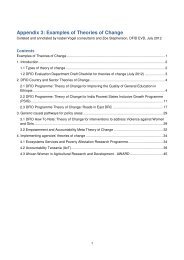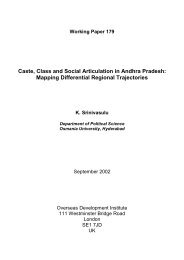Full Report - Research for Development - Department for ...
Full Report - Research for Development - Department for ...
Full Report - Research for Development - Department for ...
You also want an ePaper? Increase the reach of your titles
YUMPU automatically turns print PDFs into web optimized ePapers that Google loves.
4.3 Summary of results of causal chain analysis<br />
Synthesis results<br />
We identified seven high-quality items with evidence of successful interventions in<br />
terms of maternal and infant outcomes. The heterogeneity of the successful<br />
interventions we report here reflects our deliberately inclusive search and<br />
inclusion strategy. There are four studies (Appendix 4.9) where the positive<br />
mortality outcome was clearly targeting or, with disaggregation, could be shown to<br />
have a beneficial effect <strong>for</strong> poor urban populations. In keeping with our inclusive<br />
approach to addressing this question, however, we also present a second table<br />
(Appendix 4.10) to show those high-quality studies (n=3) with positive impact(s) on<br />
maternal and infant outcomes that (based on circumstantial evidence, <strong>for</strong> example<br />
the site of intervention) we have every reason to believe addressed a poor urban<br />
population, though this was either not stated explicitly or was unclear.<br />
Returning to the four studies, generalising from so few is inadvisable, and just one<br />
of the papers (Darmstadt et al., 2008) dealt with infant mortality. Notable,<br />
however, is that two out of the four involved service (re)organisation in some <strong>for</strong>m<br />
<strong>for</strong> maternal healthcare (Munjanja et al., 1996; Dumont et al., 2006), albeit with<br />
rather different recommendations. Munjanja et al.’s (1996) study in Zimbabwe<br />
tested whether reducing the number of routine antenatal visits and tests <strong>for</strong><br />
routine pregnancies might have had a negative impact on mortality outcomes.<br />
Their study, using a RCT design, found no significant change in perinatal and<br />
maternal mortality. Dumont et al.’s (2006) Senegalese study using be<strong>for</strong>e and<br />
after study design showed that, when applied to qualified professionals (physicians,<br />
midwives, managers), the Maternal Deaths Review (MDR) helped to improve the<br />
organisation of care, leading to significant decline in overall mortality over the<br />
study’s three year period. 16<br />
The Darmstadt et al. (2008) study in Bangladesh, using a prospective, randomised<br />
controlled design, showed significant reductions in neonatal mortality rates <strong>for</strong><br />
preterm neonates (≤33 weeks) at risk of skin infections who received emollient<br />
skin-barrier therapy. A companion paper (Le Fevre et al., 2010) (++)/(+) on the<br />
cost-effectiveness of this intervention is reviewed elsewhere in this report.<br />
Whilst all of these three interventions showed significant impact on maternal or<br />
neonatal mortality, none dealt with the issues involved in accessing the services<br />
where the interventions were provided, although the economic evaluation<br />
accompanying the last study did look at issues of sustainability. The one study that<br />
did deal with issues around accessing health services is that by Lim et al. (2010),<br />
which considered the impact of India’s JSY conditional cash-transfer scheme on<br />
maternal health outcomes through analyses of the National Family Health Service<br />
(NFHS). The claims made <strong>for</strong> the JSY programme in India by Lim et al. (2010) are<br />
not without critique (Das et al., 2010), some of which the authors have<br />
acknowledged (Lim et al., 2011), in particular that their analyses of demand-side<br />
interventions such as the JSY cannot deal with supply-side issues such as facility<br />
readiness.<br />
Turning to the studies that did not specifically report on urban areas, the three<br />
successful high-quality interventions identified to impact on infant mortality<br />
involved four very different kinds of intervention. Studies by Cobra et al. (1997)<br />
and Taha et al. (1997) targeted infants in general. The study by Taha et al. (1997)<br />
on vaginal cleansing to reduce bacterial infections, which are substantial in many<br />
16 A linked, but separate study by Dumont et al. (2005) using a similar approach is listed in Appendix<br />
4.10 <strong>for</strong> high-quality, positive interventions, but ones without explicit application to poor urban<br />
populations.<br />
What are the effects of different models of delivery <strong>for</strong> improving maternal and infant<br />
health outcomes <strong>for</strong> poor people in urban areas in low income and lower middle income<br />
countries? 51









